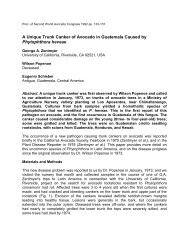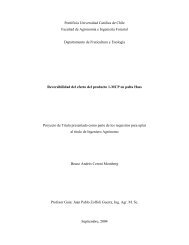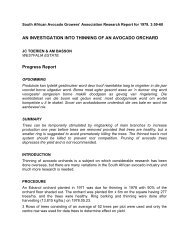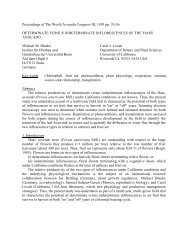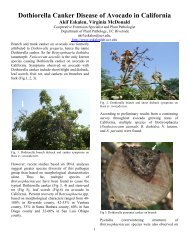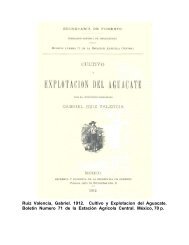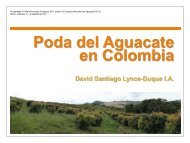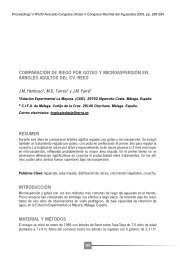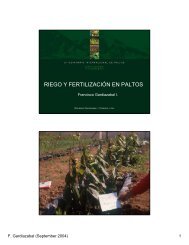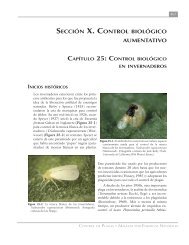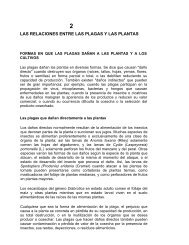Further Observations on the Ultrastructure of Avocado Fruits, Some ...
Further Observations on the Ultrastructure of Avocado Fruits, Some ...
Further Observations on the Ultrastructure of Avocado Fruits, Some ...
You also want an ePaper? Increase the reach of your titles
YUMPU automatically turns print PDFs into web optimized ePapers that Google loves.
CHAPTER 4<br />
<str<strong>on</strong>g>Fur<strong>the</strong>r</str<strong>on</strong>g> <str<strong>on</strong>g>Observati<strong>on</strong>s</str<strong>on</strong>g> <strong>of</strong> <strong>the</strong> <strong>Ultrastructure</strong> <strong>of</strong> <strong>Avocado</strong> <strong>Fruits</strong>, <strong>Some</strong><br />
Comments <strong>on</strong> Techniques, and C<strong>on</strong>clusi<strong>on</strong>s <strong>of</strong> <strong>the</strong> Dissertati<strong>on</strong><br />
Platt-Aloia, K. A. 1980. <strong>Ultrastructure</strong> <strong>of</strong> Mature and Ripening <strong>Avocado</strong> (Persea americana Mill.)<br />
Fruit Mesocarp; Scanning, Transmissi<strong>on</strong> and Freeze Fracture Electr<strong>on</strong> Microscopy. PhD.<br />
Dissertati<strong>on</strong>. University <strong>of</strong> California, Riverside. 113 pages.<br />
Chapter 4. <str<strong>on</strong>g>Fur<strong>the</strong>r</str<strong>on</strong>g> <str<strong>on</strong>g>Observati<strong>on</strong>s</str<strong>on</strong>g> <strong>on</strong> <strong>the</strong> <strong>Ultrastructure</strong> <strong>of</strong> <strong>Avocado</strong> <strong>Fruits</strong>, <strong>Some</strong> Comments <strong>on</strong><br />
Techniques, and C<strong>on</strong>clusi<strong>on</strong>s <strong>of</strong> <strong>the</strong> Dissertati<strong>on</strong><br />
60
<str<strong>on</strong>g>Fur<strong>the</strong>r</str<strong>on</strong>g> <str<strong>on</strong>g>Observati<strong>on</strong>s</str<strong>on</strong>g> <strong>on</strong> <strong>the</strong> <strong>Ultrastructure</strong> <strong>of</strong> <strong>Avocado</strong> <strong>Fruits</strong>, <strong>Some</strong><br />
Comments <strong>on</strong> Techniques, and C<strong>on</strong>clusi<strong>on</strong>s <strong>of</strong> <strong>the</strong> Dissertati<strong>on</strong><br />
INTRODUCTION<br />
During <strong>the</strong> present investigati<strong>on</strong> <strong>of</strong> <strong>the</strong> ultrastructure <strong>of</strong> mesocarp parenchyma cells <strong>of</strong><br />
ripening avocados, I also studied <strong>the</strong> oil cells and made some detailed observati<strong>on</strong>s <strong>on</strong><br />
o<strong>the</strong>r aspects <strong>of</strong> <strong>the</strong> cell ultrastructure. This chapter will c<strong>on</strong>sist <strong>of</strong> a series <strong>of</strong><br />
discussi<strong>on</strong>s <strong>of</strong> <strong>the</strong> following topics: A) The structure <strong>of</strong> <strong>the</strong> specialized oil cells or<br />
idioblasts, and a comparis<strong>on</strong> <strong>of</strong> <strong>the</strong>se with similar structures described in <strong>the</strong> stems and<br />
leaves <strong>of</strong> o<strong>the</strong>r species; B) <str<strong>on</strong>g>Observati<strong>on</strong>s</str<strong>on</strong>g> <strong>on</strong> <strong>the</strong> structure <strong>of</strong> some <strong>of</strong> <strong>the</strong> internal<br />
membranes as well as <strong>the</strong> envelope <strong>of</strong> plastids from avocado mesocarp as revealed by<br />
freeze fracture techniques; C) <str<strong>on</strong>g>Fur<strong>the</strong>r</str<strong>on</strong>g> discussi<strong>on</strong> <strong>of</strong> <strong>the</strong> changes in particle density <strong>of</strong><br />
<strong>the</strong> plasmamembrane during ripening, and additi<strong>on</strong>al data <strong>on</strong> this topic will be<br />
presented; and D) A discussi<strong>on</strong> <strong>of</strong> new techniques developed or improvements <strong>on</strong> old<br />
techniques which allowed <strong>the</strong> c<strong>on</strong>clusi<strong>on</strong> that ripening is not senescence and does not<br />
involve cell degradati<strong>on</strong>. The chapter will <strong>the</strong>n c<strong>on</strong>clude with E) A summary <strong>of</strong> <strong>the</strong><br />
c<strong>on</strong>clusi<strong>on</strong>s <strong>of</strong> <strong>the</strong> Dissertati<strong>on</strong>, and a discussi<strong>on</strong> <strong>of</strong> its significance and applicati<strong>on</strong> to<br />
o<strong>the</strong>r studies.<br />
A. IDIOBLASTS<br />
The specialized oil cells, or idioblasts, are larger than <strong>the</strong> parenchyma cells and are<br />
scattered throughout <strong>the</strong> mesocarp <strong>of</strong> <strong>the</strong> avocado fruit (fig. 1). Cummings and<br />
Schroeder (1942) noted that <strong>the</strong>se cells occupy approximately 2% <strong>of</strong> <strong>the</strong> volume <strong>of</strong> <strong>the</strong><br />
tissue. They are almost completely filled with oil which varies in electr<strong>on</strong> density and<br />
usually stains with a different density than <strong>the</strong> oil <strong>of</strong> <strong>the</strong> parenchyma cells. Although<br />
histochemical, cytochemical or biochemical analysis <strong>of</strong> <strong>the</strong> oil in <strong>the</strong>se cells were not<br />
performed in <strong>the</strong> present study, <strong>the</strong> staining characteristics <strong>of</strong> <strong>the</strong> oil after normal<br />
preparative techniques (OsO 4 , postfixati<strong>on</strong>, and uranyl acetate and lead citrate post<br />
staining) indicate some difference in compositi<strong>on</strong> between <strong>the</strong> oil <strong>of</strong> <strong>the</strong> idioblasts and<br />
that found in <strong>the</strong> cytoplasm <strong>of</strong> <strong>the</strong> parenchyma cells (figs. 1, 2). In light microscope<br />
studies <strong>of</strong> avocado, Scott et al. (1963) also noted a difference in staining <strong>of</strong> <strong>the</strong> oils <strong>of</strong><br />
<strong>the</strong> two cell types. The idioblasts are apparently not metabolically functi<strong>on</strong>al. The<br />
electr<strong>on</strong> dense cytoplasm at <strong>the</strong> periphery <strong>of</strong> <strong>the</strong> cell c<strong>on</strong>tains vesicles, small lipid<br />
droplets, and what appear to be remnants <strong>of</strong> various organelles and membranes (fig. 2).<br />
The probable reas<strong>on</strong> for this cytoplasmic degradati<strong>on</strong> can be seen by studying <strong>the</strong> walls<br />
<strong>of</strong> <strong>the</strong>se cells. There are three distinct structural layers in <strong>the</strong> walls <strong>of</strong> <strong>the</strong> idioblasts.<br />
The outermost layer appears to be a normal cellulosic wall, c<strong>on</strong>tinuous with <strong>the</strong> walls <strong>of</strong><br />
<strong>the</strong> surrounding parenchyma cells. Internal to this is a layer which occasi<strong>on</strong>ally has a<br />
striated appearance similar to that described and identified as being suberin by<br />
Kolattukudy et al., in potato tubers, and o<strong>the</strong>r tissues (Dean et al., 1977; Kolattukudy,<br />
1980). Additi<strong>on</strong>ally, previous reports <strong>on</strong> <strong>the</strong> structure <strong>of</strong> idioblasts in avocado mesocarp<br />
(Scott et al., 1963) as well as those <strong>of</strong> o<strong>the</strong>r tissues (Gross, 1978; Amelunxen and<br />
Gr<strong>on</strong>au, 1969) also describe a suberin layer in <strong>the</strong> wall surrounding <strong>the</strong> oil cell.<br />
61
The third layer, internal to <strong>the</strong> suberin, is similar to <strong>the</strong> tertiary wall described in<br />
idioblasts <strong>of</strong> a woody ranalean (Gross, 1978) and in Acorus (Amelunxen and Gr<strong>on</strong>au,<br />
1969). The staining characteristics <strong>of</strong> this tertiary wall range from light and fibrillar to<br />
quite electr<strong>on</strong> dense with granular deposits (figs. 2, 3). A somewhat ordered, layered<br />
c<strong>on</strong>structi<strong>on</strong> is <strong>of</strong>ten apparent (fig. 3), and esterified pectins are present as indicated by<br />
<strong>the</strong> positive reacti<strong>on</strong> with hydroxamic acid-FeCl 3 (fig. 4).<br />
Plasmodesmata are <strong>on</strong>ly occasi<strong>on</strong>ally seen in <strong>the</strong> primary wall <strong>of</strong> parenchyma cells<br />
adjacent to idioblasts, and serial secti<strong>on</strong>s have shown that when <strong>the</strong>y do occur, <strong>the</strong>y do<br />
not penetrate <strong>the</strong> suberin layer (fig. 5). A similar blockage <strong>of</strong> <strong>the</strong> plasmodesmata has<br />
also been reported in guard cells <strong>of</strong> Phaseolus (Wilmer and Sext<strong>on</strong>, 1979) and in <strong>the</strong><br />
basal regi<strong>on</strong> <strong>of</strong> <strong>the</strong> trichomes <strong>of</strong> Larrea (Thoms<strong>on</strong> et al., 1979), apparently as a result <strong>of</strong><br />
sec<strong>on</strong>dary wall formati<strong>on</strong>. It is <strong>the</strong>refore apparent that <strong>the</strong> c<strong>on</strong>tents <strong>of</strong> <strong>the</strong> mature<br />
idioblasts are isolated from both <strong>the</strong> symplast and <strong>the</strong> apoplast <strong>of</strong> <strong>the</strong> rest <strong>of</strong> <strong>the</strong> fruit.<br />
The necrotic appearance <strong>of</strong> <strong>the</strong> cytoplasm <strong>of</strong> <strong>the</strong>se cells could <strong>the</strong>refore be real.<br />
However, it could also be <strong>the</strong> result <strong>of</strong> an inability <strong>of</strong> aqueous fixatives to penetrate <strong>the</strong><br />
suberized layer which apparently completely surrounds <strong>the</strong> cell. A cellolosic peg with a<br />
c<strong>on</strong>siderable number <strong>of</strong> plasmodesmata, as reported by Scott et al. (1963), was not<br />
seen in this study. However extensive serial secti<strong>on</strong>s <strong>of</strong> idioblasts were not performed.<br />
B. PLASTIDS<br />
As discussed in Chapter 3, <strong>the</strong> plastids <strong>of</strong> avocado mesocarp occur in a variety <strong>of</strong><br />
forms, depending <strong>on</strong> <strong>the</strong>ir locati<strong>on</strong> in <strong>the</strong> tissue. The presence <strong>of</strong> a membrane bound<br />
inclusi<strong>on</strong> with frequent associati<strong>on</strong>s with <strong>the</strong> membranes <strong>of</strong> both grana and prolamellar<br />
bodies was noted <strong>on</strong>ly in <strong>the</strong> light green tissue, and not in <strong>the</strong> dark green or yellow parts<br />
<strong>of</strong> <strong>the</strong> fruit. Membrane bound bodies have been described in young tissues which<br />
c<strong>on</strong>tain developing chloroplasts. They have been shown to decrease in size and<br />
c<strong>on</strong>tent as <strong>the</strong> granal system develops and have <strong>the</strong>refore been implicated to have a<br />
role in <strong>the</strong> storage or producti<strong>on</strong> <strong>of</strong> granal precursors (Stetler and Laetsch, 1969; Platt-<br />
Aloia and Thoms<strong>on</strong>, 1977, 1979). Therefore, <strong>the</strong> presence <strong>of</strong> membrane bound bodies<br />
in plastids <strong>of</strong> interior cells <strong>of</strong> <strong>the</strong> avocado fruit where granal development is apparently<br />
limited by lack <strong>of</strong> light, and not in <strong>the</strong> chloroplasts <strong>of</strong> <strong>the</strong> outer, dark green tissues, might<br />
be fur<strong>the</strong>r evidence <strong>of</strong> a developmental relati<strong>on</strong>ship between <strong>the</strong> c<strong>on</strong>tents <strong>of</strong> <strong>the</strong><br />
membrane bound bodies and <strong>the</strong> photosyn<strong>the</strong>tic membranes. The results <strong>of</strong> freeze<br />
fracture studies <strong>of</strong> <strong>the</strong>se plastids appears to fur<strong>the</strong>r corroborate this suggesti<strong>on</strong> by <strong>the</strong><br />
presence <strong>of</strong> large, 130-150Å, intramembranous particles (IMPs) in <strong>the</strong> membrane <strong>of</strong><br />
what appears to be a membrane bound body (fig. 1). These large particles have been<br />
reported to occur <strong>on</strong>ly in <strong>the</strong> photosyn<strong>the</strong>tic membranes <strong>of</strong> chloroplasts (Sprey and<br />
Laetsch, 1976; Miller et al., 1977), and have been correlated with <strong>the</strong> presence <strong>of</strong> light<br />
reacti<strong>on</strong> centers. The presence <strong>of</strong> <strong>the</strong>se large IMPs in <strong>the</strong> membrane <strong>of</strong> <strong>the</strong> membrane<br />
bound body might be evidence <strong>of</strong> a partial incorporati<strong>on</strong> <strong>of</strong> comp<strong>on</strong>ents <strong>of</strong> <strong>the</strong><br />
photosyn<strong>the</strong>tic apparatus into this membrane.<br />
When <strong>the</strong> envelope <strong>of</strong> plastids is freeze fractured, <strong>the</strong> fracture plane frequently skips<br />
from <strong>on</strong>e envelope to <strong>the</strong> o<strong>the</strong>r (fig. 8). The EF face <strong>of</strong> <strong>the</strong> outer envelope membrane<br />
has a low density <strong>of</strong> particles (650 IMPs/µm 2 ) and <strong>the</strong> PF face <strong>of</strong> <strong>the</strong> inner envelope is<br />
particle-rich (2900 IMPs/µm 2 ). Very few studies <strong>of</strong> freeze fractured chloroplasts have<br />
62
included density counts <strong>of</strong> <strong>the</strong> inner and outer envelope membranes. Sprey and<br />
Laetsch (1976) reported densities <strong>of</strong> 133±23 particles/ µm 2 <strong>on</strong> <strong>the</strong> EF face <strong>of</strong> <strong>the</strong> outer<br />
envelope and 18201167 particles/ µm 2 <strong>on</strong> <strong>the</strong> PF face <strong>of</strong> <strong>the</strong> inner envelope <strong>of</strong> isolated<br />
spinach chloroplasts (Table 1). Bisalputra and Bailey (1973) reported 170 IMPs/ µm 2<br />
for <strong>the</strong> EF face <strong>of</strong> <strong>the</strong> outer envelope and 240 IMPs/ µm 2 for <strong>the</strong> PF face <strong>of</strong> <strong>the</strong> inner<br />
envelope <strong>of</strong> <strong>the</strong> chloroplasts <strong>of</strong> <strong>the</strong> red alga Banzia. Although my data are <strong>on</strong>ly<br />
preliminary, <strong>the</strong> figures from both <strong>of</strong> <strong>the</strong> above studies are lower than we have found for<br />
<strong>the</strong> particle densities <strong>of</strong> avocado plastid envelopes. However, Milk<strong>on</strong>ian and Robenik<br />
(1979) have recently studied particle densities in <strong>the</strong> outer chloroplast envelope <strong>of</strong> <strong>the</strong><br />
flagellate Tetraselmis and <strong>the</strong>ir result <strong>of</strong> 567±82 IMPs/ µm 2 for <strong>the</strong> EF face is similar to<br />
those found for avocado plastids. The differences in particle densities, especially in <strong>the</strong><br />
outer envelope might reflect ei<strong>the</strong>r preparative and/or functi<strong>on</strong>al differences and<br />
<strong>the</strong>refore fur<strong>the</strong>r investigati<strong>on</strong> is required.<br />
C. PLASMALEMMA CHANGES DURING RIPENING<br />
As discussed in Chapter 3, <strong>the</strong> significance <strong>of</strong> <strong>the</strong> changes in particle density <strong>of</strong> <strong>the</strong> EF<br />
face <strong>of</strong> <strong>the</strong> plasmamembrane <strong>of</strong> avocado mesocarp parenchyma cells during ripening is<br />
unknown, and interpretati<strong>on</strong>s are speculative.<br />
In order to quantify <strong>the</strong> increase in particle density observed in this study, histograms<br />
were made <strong>of</strong> <strong>the</strong> frequency distributi<strong>on</strong> <strong>of</strong> particles in <strong>the</strong> 0.01 µm 2 subdivisi<strong>on</strong>s <strong>of</strong> <strong>the</strong><br />
grid used for counts (Table 2). During <strong>the</strong> climacteric rise (Table 2B), <strong>the</strong>re is a possible<br />
indicati<strong>on</strong> <strong>of</strong> a biphasic distributi<strong>on</strong> <strong>of</strong> particle density, with peaks at 13 and 19<br />
particles/0.01 µm 2 . These peaks coincide with <strong>the</strong> peaks observed in preclimacteric<br />
and climacteric peak membranes, respectively, and <strong>the</strong>refore most likely corresp<strong>on</strong>d to<br />
counts made from membranes at early and late stages <strong>of</strong> <strong>the</strong> rise. This c<strong>on</strong>clusi<strong>on</strong> is<br />
supported by <strong>the</strong> decrease in frequency <strong>of</strong> 13 IMPs/0.01 µm 2 counts <strong>of</strong> particle<br />
frequency <strong>of</strong> <strong>the</strong> climacteric peak membranes.<br />
The observed increase in particle number coincides with several prominent<br />
physiological phenomena which might be correlated with an increase in<br />
intramembranous particles in <strong>the</strong> plasmamembrane. These phenomena include: 1) <strong>the</strong><br />
peak <strong>of</strong> C 2 H 2 producti<strong>on</strong>; 2) apparent fusi<strong>on</strong> <strong>of</strong> ER vesicles with <strong>the</strong> plasmamembrane,<br />
and 3) maximum activity <strong>of</strong> wall hydrolytic enzymes.<br />
1) The evoluti<strong>on</strong> and release <strong>of</strong> ethylene has been shown to have an apparent<br />
requirement for <strong>the</strong> presence <strong>of</strong> <strong>the</strong> plasmamembrane (Matoo and Lieberman, 1977;<br />
Anders<strong>on</strong>, Lieberman and Stewart, 1979). Additi<strong>on</strong>ally, Laties (Lieberman, 1979)<br />
has evidence from 13 C/ 12 C ratios that <strong>the</strong> ethylene produced during <strong>the</strong> climacteric<br />
may be, at least partially, derived from fatty acids <strong>of</strong> <strong>the</strong> membrane lipids.<br />
Therefore, <strong>the</strong> interacti<strong>on</strong> <strong>of</strong> a lipophilic substance, such as ethylene, with <strong>the</strong><br />
membrane, and/or <strong>the</strong> utilizati<strong>on</strong> <strong>of</strong> membrane fatty acids in <strong>the</strong> producti<strong>on</strong> <strong>of</strong><br />
ethylene might result in perturbati<strong>on</strong>s <strong>of</strong> <strong>the</strong> membrane comp<strong>on</strong>ents. However, <strong>the</strong>re<br />
is no evidence to support an ethylene-induced incorporati<strong>on</strong> <strong>of</strong> IMPs, even <strong>the</strong><br />
inducti<strong>on</strong> <strong>of</strong> n<strong>on</strong>-protein IMPs, in <strong>the</strong> form <strong>of</strong> inverted micelles, as shown by De<br />
Kruijff et al. (1979, 1980). Therefore, it does not appear that ethylene producti<strong>on</strong> is<br />
<strong>the</strong> physiological correlate <strong>of</strong> <strong>the</strong> increased number <strong>of</strong> IMPs in <strong>the</strong> climacteric peak<br />
plasmamembranes.<br />
63
2) There also appears to be a vesiculati<strong>on</strong> <strong>of</strong> <strong>the</strong> endoplasmic reticulum during ripening<br />
<strong>of</strong> avocados, as discussed in Chapter 3. These vesicles apparently fuse with <strong>the</strong><br />
plasmamembrane, and are possibly involved in <strong>the</strong> secreti<strong>on</strong> <strong>of</strong> wall hydrolytic<br />
enzymes, or some o<strong>the</strong>r aspect <strong>of</strong> ripening. Freeze fracture studies <strong>of</strong> membrane<br />
fusi<strong>on</strong> events frequently report rearrangement <strong>of</strong> IMPs into rosettes, or aggregati<strong>on</strong><br />
<strong>of</strong> particles resulting in particle-depleted areas (see Satir, 1980, for review).<br />
However, <strong>the</strong>se or o<strong>the</strong>r rearrangements <strong>of</strong> IMPs were not seen at any stage <strong>of</strong><br />
ripening in avocados. C<strong>on</strong>sequently, membrane fusi<strong>on</strong> does not appear to be <strong>the</strong><br />
physiological correlate <strong>of</strong> increased particle density seen during <strong>the</strong> climacteric,<br />
unless, increased numbers <strong>of</strong> IMPs are required for <strong>the</strong> fusi<strong>on</strong> process to occur in<br />
avocados.<br />
3) Ano<strong>the</strong>r aspect <strong>of</strong> ripening which is at a maximum at <strong>the</strong> climacteric peak is <strong>the</strong><br />
activity <strong>of</strong> <strong>the</strong> wall hydrolytic enzymes cellulase and polygalactur<strong>on</strong>ase (Awad and<br />
Young, 1979). It is possible that transport <strong>of</strong> <strong>the</strong>se enzymes across <strong>the</strong><br />
plasmamembrane may be occurring, and this activity could result in a transient<br />
increase in <strong>the</strong> particle density <strong>of</strong> <strong>the</strong> membrane. Cellulase has been shown to be<br />
associated with <strong>the</strong> plasmalemma in kidney bean abscissi<strong>on</strong> z<strong>on</strong>es (Koehler et al.,<br />
1976). It is possible that this is also true in avocados, and <strong>the</strong> increased particle<br />
density reflects an increase in membrane-associated cellulase or o<strong>the</strong>r enzymes.<br />
Definitive c<strong>on</strong>clusi<strong>on</strong>s c<strong>on</strong>cerning <strong>the</strong> particle density changes <strong>of</strong> <strong>the</strong> plasmamembrane<br />
during ripening cannot be made at this time. Additi<strong>on</strong>al studies must be made to<br />
determine whe<strong>the</strong>r <strong>the</strong>re is a complementary decrease in <strong>the</strong> density <strong>of</strong> particles in <strong>the</strong><br />
PF face. This would indicate a change in partiti<strong>on</strong>ing <strong>of</strong> <strong>the</strong> particles ra<strong>the</strong>r than a total<br />
increase in density. Isolati<strong>on</strong> <strong>of</strong> <strong>the</strong> plasmamembrane and labeling <strong>of</strong> this fracti<strong>on</strong> with<br />
anticellulase-ferritin c<strong>on</strong>jugates may be informative in determining <strong>the</strong> possibility that <strong>the</strong><br />
particles represent cellulase. The ultimate significance <strong>of</strong> this aspect <strong>of</strong> <strong>the</strong> study, and<br />
that <strong>of</strong> <strong>the</strong> chloroplast envelope freeze fracture, will depend not <strong>on</strong>ly <strong>on</strong> future results <strong>on</strong><br />
<strong>the</strong>se tissues, but <strong>on</strong> <strong>the</strong> findings <strong>of</strong> o<strong>the</strong>r experiments in determining <strong>the</strong> true nature <strong>of</strong><br />
<strong>the</strong> intramembranous particles visualized by <strong>the</strong> freeze fracture technique.<br />
D. SOME COMMENTS ON TECHNIQUES<br />
Probably <strong>the</strong> most significant result <strong>of</strong> this study was <strong>the</strong> accomplishment <strong>of</strong> satisfactory<br />
preservati<strong>on</strong> <strong>of</strong> <strong>the</strong> delicate tissues <strong>of</strong> <strong>the</strong> s<strong>of</strong>t, ripe fruits. A combinati<strong>on</strong> <strong>of</strong> several<br />
factors was found to be necessary. The first was <strong>the</strong> use <strong>of</strong> low osmolarity buffer (50<br />
mM) for <strong>the</strong> initial glutaraldehyde fixati<strong>on</strong>, as well as in <strong>the</strong> subsequent washes and post<br />
fixati<strong>on</strong>. Sext<strong>on</strong> et al. (1974, 1977, and pers<strong>on</strong>al communicati<strong>on</strong>) also found that low<br />
osmotic strength buffers allowed good preservati<strong>on</strong> <strong>of</strong> <strong>the</strong> delicate cells <strong>of</strong> <strong>the</strong><br />
abscissi<strong>on</strong> z<strong>on</strong>e.<br />
The sec<strong>on</strong>d factor which I found to improve fixati<strong>on</strong> was an overnight exposure to OsO 4 .<br />
Although l<strong>on</strong>g osmium postfixati<strong>on</strong> has, in our experience, not been found necessary in<br />
most circumstances, certain plant tissues apparently require this treatment. These<br />
tissues have <strong>the</strong> comm<strong>on</strong> characteristic <strong>of</strong> a large amount <strong>of</strong> very osmiophilic substances,<br />
such as <strong>the</strong> oils <strong>of</strong> <strong>the</strong> avocado, or <strong>the</strong> resinous secreti<strong>on</strong>s <strong>of</strong> Larrea (Thoms<strong>on</strong><br />
et al., 1979). It was found that overnight osmium treatment allowed sufficient time for<br />
adequate infiltrati<strong>on</strong> and reacti<strong>on</strong> <strong>of</strong> <strong>the</strong> osmium with <strong>the</strong> tissue.<br />
64
Ano<strong>the</strong>r factor in <strong>the</strong> preparati<strong>on</strong> <strong>of</strong> avocado mesocarp which seemed to improve<br />
preservati<strong>on</strong> <strong>of</strong> <strong>the</strong> delicate cells was a very slow initial infiltrati<strong>on</strong> <strong>of</strong> <strong>the</strong> epoxy<br />
embedding medium. The tissue pieces were placed in 1 ml. <strong>of</strong> 100% acet<strong>on</strong>e, and <strong>the</strong><br />
epoxy was added dropwise over several (5-6) hours until it was approximately 50%, at<br />
which time <strong>the</strong> rate <strong>of</strong> additi<strong>on</strong> was increased, and finally <strong>the</strong> tissue was placed in 100%<br />
resin and left at room temperature overnight, before final polimerizati<strong>on</strong> at 70°C. The<br />
rati<strong>on</strong>ale for <strong>the</strong> slow infiltrati<strong>on</strong> is that <strong>the</strong> "fr<strong>on</strong>t" <strong>of</strong> resin moving through <strong>the</strong> tissue<br />
presents a certain amount <strong>of</strong> stress which would be reduced by a smaller gradient <strong>of</strong><br />
change in viscosity between <strong>the</strong> fluid already in <strong>the</strong> cell and that moving into <strong>the</strong> cell.<br />
The final procedure used in <strong>the</strong> present study which allowed optimum subcellular<br />
preservati<strong>on</strong> was found necessary because <strong>of</strong> <strong>the</strong> large size <strong>of</strong> <strong>the</strong> cells in avocado<br />
mesocarp. It was found that by trimming deeper than usual into <strong>the</strong> block for secti<strong>on</strong>ing,<br />
fewer cells exhibited degradative changes. This has been found to be a problem with<br />
many tissues. Evidently, more than just <strong>the</strong> outermost layer <strong>of</strong> cells is damaged or<br />
shows incipient degradati<strong>on</strong> due to cutting <strong>of</strong> <strong>the</strong> tissue in <strong>the</strong> initial preparati<strong>on</strong> for<br />
microscopy. For <strong>the</strong> present study, large samples taken from <strong>the</strong> fruit were placed<br />
immediately into 2.5%, buffered glutaraldehyde and were <strong>the</strong>n cut into smaller pieces<br />
while submerged in <strong>the</strong> fixative. After embedding, samples were trimmed deep enough<br />
to remove <strong>the</strong> outermost 2-3 cell layers. Usually, even <strong>the</strong>n, several cells in a secti<strong>on</strong><br />
exhibited some form <strong>of</strong> damage, but <strong>the</strong> presence <strong>of</strong> well preserved cells in <strong>the</strong> same<br />
secti<strong>on</strong>s indicated that this occasi<strong>on</strong>al degradati<strong>on</strong> was due to damage during<br />
preparati<strong>on</strong>, ra<strong>the</strong>r than incipient senescence.<br />
Freeze fracture <strong>of</strong> whole plant cells presents technical problems not encountered with<br />
membrane fracti<strong>on</strong>s or most animal tissues. The primary c<strong>on</strong>cern is <strong>the</strong> removal <strong>of</strong> <strong>the</strong><br />
cuticle from <strong>the</strong> replica. Although cuticle is not present, and <strong>the</strong>refore not a problem, in<br />
avocado mesocarp <strong>the</strong> technique devised for dissolving cuticle from o<strong>the</strong>r plants was<br />
useful in removing <strong>the</strong> excess oil <strong>of</strong> avocados, thus allow-ing a good, clean replica. The<br />
technique calls for a several hour wash in each <strong>of</strong> sulfuric-chromic acid, and 12% KOH<br />
in 95% EtOH. Since <strong>the</strong> alcohol evaporates, it cannot be left overnight, as <strong>the</strong> acid<br />
wash. However, several hours seems to be sufficient for <strong>the</strong> removal <strong>of</strong> both oils and<br />
cuticles from <strong>the</strong> replicas.<br />
E. CONCLUSIONS AND SIGNIFICANCE OF THE DISSERTATION<br />
In summary, when studying a delicate or apparently senescing tissue accurate<br />
c<strong>on</strong>clusi<strong>on</strong>s can <strong>on</strong>ly be drawn if <strong>the</strong> cells are prepared in such a way that any artifacts<br />
due to damage are completely eliminated. When this study was begun, it was felt that<br />
by combining <strong>the</strong> three different preparative and examining techniques <strong>of</strong> thin secti<strong>on</strong>,<br />
freeze fracture, and scanning electr<strong>on</strong> microscopy, natural degradati<strong>on</strong> could more<br />
easily be differentiated from damaging artifacts. This would allow an evaluati<strong>on</strong> <strong>of</strong> <strong>the</strong><br />
actual degree <strong>of</strong> deteriorati<strong>on</strong> <strong>of</strong> cells and organelles which occur during ripening, and<br />
provide a means for a more accurate assessment <strong>of</strong> whe<strong>the</strong>r ripening should be<br />
c<strong>on</strong>sidered a senescence phenomen<strong>on</strong>. Additi<strong>on</strong>ally, <strong>the</strong> use <strong>of</strong> <strong>the</strong> SEM in combinati<strong>on</strong><br />
with <strong>the</strong> osmium-ligand binding preparative technique allows a much more detailed<br />
study <strong>of</strong> <strong>the</strong> three-dimensi<strong>on</strong>al structure and interrelati<strong>on</strong>ships <strong>of</strong> <strong>the</strong> various organelles.<br />
This ability has not been previously available, and should provide valuable informati<strong>on</strong><br />
65
c<strong>on</strong>cerning ultrastructural organizati<strong>on</strong> in many different tissues. It will also provide a<br />
means for assessing changes in subcellular organizati<strong>on</strong> which may occur during<br />
several o<strong>the</strong>r developmental or functi<strong>on</strong>al transiti<strong>on</strong>s.<br />
The primary c<strong>on</strong>clusi<strong>on</strong> <strong>of</strong> <strong>the</strong> dissertati<strong>on</strong> is that, in <strong>the</strong> avocado, ripening and<br />
senescence are two distinct and separate processes. This finding at <strong>the</strong> ultrastructural<br />
level, provides support for previous biochemical and physiological studies which<br />
indicate c<strong>on</strong>tinued biosyn-<strong>the</strong>sis and cellular functi<strong>on</strong>ing during ripening. <str<strong>on</strong>g>Fur<strong>the</strong>r</str<strong>on</strong>g>, this<br />
study indicates <strong>the</strong> need for a similar, multi-faceted approach to studies <strong>on</strong> <strong>the</strong><br />
ultrastructure <strong>of</strong> <strong>the</strong> ripening process <strong>of</strong> o<strong>the</strong>r fruits, as well as o<strong>the</strong>r systems thought to<br />
be undergoing senescence. The possibility that tissue degradati<strong>on</strong> as revealed by<br />
ultrastructural or leakage studies is due to artifactual damage during preparati<strong>on</strong> ra<strong>the</strong>r<br />
than due to senescence, was verified by Sext<strong>on</strong> et al. (1974, 1977) in <strong>the</strong>ir studies <strong>of</strong><br />
abscissi<strong>on</strong> z<strong>on</strong>es. They showed <strong>the</strong> z<strong>on</strong>e to be composed <strong>of</strong> intact, apparently<br />
functi<strong>on</strong>al cells, even after abscissi<strong>on</strong> had occurred. This was c<strong>on</strong>trary to previous<br />
studies <strong>of</strong> Bornman (1967) and Webster (1973), which led to <strong>the</strong> c<strong>on</strong>clusi<strong>on</strong> that<br />
abscissi<strong>on</strong> was a senescence phenomen<strong>on</strong>.<br />
The need to differentiate ripening and senescence, as pointed out in <strong>the</strong> Introducti<strong>on</strong>, is<br />
not merely a matter <strong>of</strong> semantics, but if, as this study indicated, <strong>the</strong>y are separate and<br />
distinct phenomena, <strong>the</strong>n biochemical and physiological, as well as ultrastructural<br />
studies <strong>of</strong> each process will <strong>on</strong>ly be significant or useful if ripening and senescence are<br />
treated as different processes.<br />
REFERENCES<br />
Amelunxen, F. and Cr<strong>on</strong>au, G. 1969. Elektr<strong>on</strong>enmikroskipische Unter- suchungen an<br />
den Olzellen v<strong>on</strong> Acorus calmus L. Z. Pflanzenphysiol. 60:156-168.<br />
Anders<strong>on</strong>, J. D., Lieberman, M. and Stewart, R. N. 1979. Ethylene producti<strong>on</strong> by apple<br />
protoplasts. Plant Physiol. 63:931-935.<br />
Awad, M. and Young, R. E. 1979. Postharvest variati<strong>on</strong> in cellulase, polygalactur<strong>on</strong>ase,<br />
and pectinmethylesterase in avocado (Persea americana Mill, c.v. Fuerte) fruits in<br />
relati<strong>on</strong> to respirati<strong>on</strong> and ethylene producti<strong>on</strong>. Plant Physiol. 64:306-308.<br />
Bisalputra, T. and Bailey, A. 1973. The fine structure <strong>of</strong> <strong>the</strong> chloroplast envelope <strong>of</strong> a<br />
Red Alga, Bangia fusco-purpurea. Protoplasma 76:443-454.<br />
Bornman, C. H. 1967. <strong>Some</strong> ultrastructural aspects <strong>of</strong> abscissi<strong>on</strong> in Coleus and<br />
Gossypium. S. Afr. J. Sci. 63:325-331.<br />
Cummings, K. and Schroeder, C. A. 1942. Anatomy <strong>of</strong> <strong>the</strong> avocado fruit. Calif. <strong>Avocado</strong><br />
Soc. Yearbook. 56-64.<br />
Dean, B. B., Kolattukudy, P. E. and Davis, R. W. 1977. Chemical compositi<strong>on</strong> and<br />
ultrastructure <strong>of</strong> suberin from hollow heart tissue <strong>of</strong> potato tubers (Solamun<br />
tuberosum). Plant Physiol. 59:1008-1010.<br />
DeKruijff, B., Cullis, P. R. and Verkleij, A. J. 1980. N<strong>on</strong>-bilayer structures in model and<br />
biological membranes, TIBS 5:79-81.<br />
DeKruijff, B., Verkley, A. J., Van Echteld, C. J. A., Gerritsen, W. J., Members, C.,<br />
66
Noordam, P. C. and De Gier, J. 1979. Occurrence 31 <strong>of</strong> lipidic particles in lipid<br />
bilayers as seen by P NMR and freeze fracture electr<strong>on</strong> microscopy. Biochim.<br />
Biophys. Acta 555: 200-209.<br />
Koehler, D. E. , Le<strong>on</strong>ard, R. T., Vanderwoude, W. J., Linkins, A. E., and Lewis, L. N.<br />
1976. Associati<strong>on</strong> <strong>of</strong> latent cellulase activity with plasma membranes from kidney<br />
bean abscissi<strong>on</strong> z<strong>on</strong>es. Plant Physiol. 58:324-330.<br />
Kolattukudy, P. E. 1980. Biopolyester membranes <strong>of</strong> plants: cutin and suberin.<br />
Science 208:990-1000.<br />
Lieberman, M. 1379. Biosyn<strong>the</strong>sis and acti<strong>on</strong> <strong>of</strong> ethylene. Ann. Rev. Plant Physiol.<br />
30:533-599.<br />
Mattoo, A. K. and Lieberman. M. 1977. Localizati<strong>on</strong> <strong>of</strong> <strong>the</strong> ethylene-syn<strong>the</strong>sizing<br />
system in apple tissue. Plant Physiol. 60:794-799.<br />
Melk<strong>on</strong>ian, M. and Robenek, H. 1979. The eyespot <strong>of</strong> <strong>the</strong> flagellate Tetraselmis<br />
cordiformis Stein (Chlorophyceae): structural specializati<strong>on</strong> <strong>of</strong> <strong>the</strong> outer chloroplast<br />
membrane and its possible significance in phototaxis <strong>of</strong> Green Algae. Protoplasma<br />
100:183-197.<br />
Miller, K. R. , Miller, G. J. and Mclntyre, K. R. 1977. Organizati<strong>on</strong> <strong>of</strong> <strong>the</strong> photosyn<strong>the</strong>tic<br />
membrane in maize mesophyll and bundle sheath chloroplasts. Biochim. Biophys.<br />
Acta 459:145-156.<br />
Gross, J. W. 1977. The Fine Structure and Development <strong>of</strong> a Woody Ranalean Oil Cell.<br />
Masters Thesis. Miami University, Oxford, Ohio. 58 pp.<br />
Platt-Aloia, K. A. and Thoms<strong>on</strong>, W. W. 1977. Chloroplast development in young<br />
sesame plants. New Phytologist 78:599-605.<br />
Platt-Aloia, K. A. and Thoms<strong>on</strong>, W. W. 1979, Membrane bound inclusi<strong>on</strong>s In epidermal<br />
plastids <strong>of</strong> developing sesame leaves and cotyled<strong>on</strong>s. New Phytologist 83:793-799.<br />
Satir, B. 1980. The role <strong>of</strong> local design in membranes. In: Membrane- Membrane<br />
Interacti<strong>on</strong>s. Nort<strong>on</strong> B. Gilula, ed. Raven Press, New York, pp. 45-58.<br />
Scott, F. M., Bystrom, B. G. and Bowler, E. 1963. Persea americana, mesocarp cell<br />
structure, light and electr<strong>on</strong> microscope study. Bot. Gaz. 124:423-428.<br />
Sext<strong>on</strong>, R. and J. L. Hall. 1974. Fine structure and cytochemistry <strong>of</strong> <strong>the</strong> abscissi<strong>on</strong><br />
z<strong>on</strong>e cells <strong>of</strong> Phaseolus leaves. I. Ultrastructural changes occurring during<br />
abscissi<strong>on</strong>. Ann. Bot. 38: 849-854.<br />
Sext<strong>on</strong>, R., Jamies<strong>on</strong>, G. G. C., and Allan, M. H. I. L. 1977. An ultrastructural study <strong>of</strong><br />
abscissi<strong>on</strong> z<strong>on</strong>e cells with special reference to <strong>the</strong> mechanism <strong>of</strong> enzyme secreti<strong>on</strong>.<br />
Protoplasma 91: 369-387.<br />
Sprey, B. and Laetsch, W. M. 1976. Chloroplast envelopes <strong>of</strong> Spinacia oleracea L. III.<br />
Freeze-fracturing <strong>of</strong> chloroplast envelopes. Z. Pflanzenphysiol. 78:360-371.<br />
Stetler, D. A, and Laetsch. W. M. 1969. Chloroplast development in Nicotiana tabecum<br />
'Maryland Mammoth.' Amer. J. Bot. 48;:260-270.<br />
Thoms<strong>on</strong>, W. W., Koeller, D., and Platt-Aloia, K. A. 1979. <strong>Ultrastructure</strong> and<br />
67
development <strong>of</strong> <strong>the</strong> trichomes <strong>of</strong> Larrea (Creosote Bush). Bot. Gaz. 140:249-260.<br />
Webster, B. D. 1973. Ultrastructural studies <strong>of</strong> abscissi<strong>on</strong> in Phaseolus; ethylene<br />
effects <strong>on</strong> cell walls. Amer. J. Bot. 60:436-447.<br />
Wilmer, C. M. and Sext<strong>on</strong>, R. 1979. Stomata and plasmodesmata. Protoplasma<br />
100:113-124.<br />
68
Table 2. Histogram <strong>of</strong> <strong>the</strong> frequency<br />
distributi<strong>on</strong> <strong>of</strong> intramembranous 2<br />
particles (IMPs) in <strong>the</strong> 0.01µ subdivisi<strong>on</strong>s<br />
<strong>of</strong> <strong>the</strong> quadrants used for particle density<br />
counts <strong>of</strong> <strong>the</strong> EF fracture face <strong>of</strong> <strong>the</strong><br />
plasma membranes <strong>of</strong> avocado mesocarp<br />
cells at various stages <strong>of</strong> ripening. The<br />
pre- (A) and post- (D) climacteric<br />
membranes have 2 fairly definite peaks at<br />
13 to 16 particles/0.01µ, whereas <strong>the</strong><br />
predominant density <strong>of</strong> IMPs <strong>of</strong> <strong>the</strong><br />
membranes from <strong>the</strong> climacteric peak<br />
membranes (C) is 16-24, much higher<br />
than <strong>the</strong> o<strong>the</strong>rs. The membranes from<br />
fruit during <strong>the</strong> climacteric rise (B) in<br />
respirati<strong>on</strong> exhibit a biphasic distributi<strong>on</strong><br />
<strong>of</strong> particle counts with 2 peaks at both <strong>the</strong><br />
lower, 12-14 count and at 18-20<br />
counts/0.01µ. This figure fur<strong>the</strong>r illustrates<br />
<strong>the</strong> apparent gradual increase in particle<br />
density in <strong>the</strong> EF face <strong>of</strong> <strong>the</strong><br />
plasmamembrane <strong>of</strong> avocado mesocarp<br />
cells during <strong>the</strong> climacteric rise in<br />
respirati<strong>on</strong>, with a peak in density at <strong>the</strong><br />
climacteric peak, and a subsequent<br />
decrease in density in <strong>the</strong> post climacteric<br />
fruit.<br />
69
FIGURES AND FIGURE LEGENDS<br />
1. Low magnificati<strong>on</strong> electr<strong>on</strong> micrograph <strong>of</strong> an oil cell and surround- ing parenchyma<br />
cells in <strong>the</strong> mesocarp <strong>of</strong> a mature, unripe avocado, The oil cell (0) is almost<br />
completely filled with a light-stain- ing oil, and <strong>the</strong> remains <strong>of</strong> <strong>the</strong> cytoplasm (OC) are<br />
barely discernable at <strong>the</strong> periphery <strong>of</strong> <strong>the</strong> cell. The oil (L) <strong>of</strong> <strong>the</strong> surrounding<br />
parenchyma is more electr<strong>on</strong> dense than that in <strong>the</strong> oil cell. X 750.<br />
2. Electr<strong>on</strong> micrograph <strong>of</strong> a porti<strong>on</strong> <strong>of</strong> an oil cell and an adjoining parenchyma cell.<br />
The oil in <strong>the</strong> idioblast (O) is less electr<strong>on</strong> dense than that in <strong>the</strong> parenchyma cell<br />
(L). The cytoplasmic remains <strong>of</strong> <strong>the</strong> oil cell (OC) are electr<strong>on</strong> dense and<br />
degenerate; few organelles or membranes are discernable. The tertiary cell wall (T)<br />
adjacent to <strong>the</strong> cytoplasm is electr<strong>on</strong> dense and fibrous in c<strong>on</strong>sistency. A suberin<br />
layer (S) is visible at <strong>the</strong> outer edge <strong>of</strong> <strong>the</strong> tertiary wall. The primary wall (PW) <strong>of</strong> <strong>the</strong><br />
oil cell is c<strong>on</strong>tinuous with <strong>the</strong> walls <strong>of</strong> <strong>the</strong> adjacent parenchyma cells (PC). X 7,400.<br />
3. Higher magnificati<strong>on</strong> electr<strong>on</strong> micrograph <strong>of</strong> <strong>the</strong> wall <strong>of</strong> an oil cell. The fibrous<br />
nature <strong>of</strong> <strong>the</strong> tertiary wall (T) is evident, as is <strong>the</strong> layered appearance <strong>of</strong> <strong>the</strong> suberin<br />
layer (S) between <strong>the</strong> tertiary and primary (PW) walls. The oil (O) <strong>of</strong> <strong>the</strong> oil cell is<br />
fairly electr<strong>on</strong> dense in this case, as is <strong>the</strong> cytoplasm <strong>of</strong> <strong>the</strong> oil cell (OC). X 30,600.<br />
4. Electr<strong>on</strong> micrograph <strong>of</strong> porti<strong>on</strong>s <strong>of</strong> an oil cell (0) and adjoining parenchyma cells<br />
(PC) which have been treated with hydroxamic acid and FeCl as a stain for pectins.<br />
Both <strong>the</strong> primary and tertiary walls stain positively for pectin esters. The suberin<br />
layer appears electr<strong>on</strong> transparent and somewhat wider than normal after this<br />
treatment. X 7,500.<br />
70
5. Electr<strong>on</strong> micrograph <strong>of</strong> <strong>the</strong> cell wall <strong>of</strong> a parenchyma cell adjacent to an oil cell<br />
illustrating <strong>the</strong> apparent blockage <strong>of</strong> plasmodesmata (Pd) at <strong>the</strong> suberin layer(S).<br />
This is <strong>on</strong>e <strong>of</strong> several serial secti<strong>on</strong>s through this regi<strong>on</strong> and this micrograph<br />
illustrates <strong>the</strong> deepest penetrati<strong>on</strong> <strong>of</strong> this group <strong>of</strong> plasmodesmata into <strong>the</strong> wall.<br />
This fruit was at <strong>the</strong> climacteric peak, and illustrates a loosening <strong>of</strong> <strong>the</strong> tertiary wall<br />
(T) <strong>of</strong> <strong>the</strong> oil cell as well as <strong>of</strong> <strong>the</strong> primary wall (PW) <strong>of</strong> <strong>the</strong> parenchyma cell. The<br />
endoplasmic reticulum (ER) <strong>of</strong> <strong>the</strong> parenchyma cell is vesiculated, as is normal for<br />
this stage <strong>of</strong> ripening. X 27,800.<br />
6. Plastid from <strong>the</strong> light green porti<strong>on</strong> <strong>of</strong> <strong>the</strong> mesocarp <strong>of</strong> <strong>the</strong> mesophyll <strong>of</strong> an avocado<br />
fruit. The membrane bound body (MB) shows apparent c<strong>on</strong>tinuity with <strong>the</strong><br />
membranes <strong>of</strong> <strong>the</strong> grana (G). A small prolamellar body (PB) is present. X 36,100.<br />
7. Freeze fracture replica <strong>of</strong> a plastid from <strong>the</strong> light green tissue <strong>of</strong> <strong>the</strong> mesocarp <strong>of</strong> an<br />
avocado. A prolamellar body (PB) in <strong>the</strong> upper half <strong>of</strong> <strong>the</strong> plastid is apparently<br />
c<strong>on</strong>tinuous with membranes which c<strong>on</strong>tain intramembranous particles with a<br />
diameter <strong>of</strong> ISO- ISO A. In <strong>the</strong> lower part <strong>of</strong> <strong>the</strong> plastid what appears to be a<br />
membrane bound body (MB) also c<strong>on</strong>tains large (130-150 A) particles (IMPs). These<br />
IMPs <strong>of</strong> <strong>the</strong> internal membranes <strong>of</strong> <strong>the</strong> plastid appear larger than <strong>the</strong> IMPs <strong>of</strong> <strong>the</strong><br />
plasmamembrane shown in <strong>the</strong> upper right hand corner <strong>of</strong> <strong>the</strong> figure (PM). The<br />
arrowhead in <strong>the</strong> lower left corner indicates <strong>the</strong> directi<strong>on</strong> <strong>of</strong> shadow. X 29,000.<br />
8. Freeze fracture electr<strong>on</strong> micrograph <strong>of</strong> a plastid from <strong>the</strong> mesocarp <strong>of</strong> a mature,<br />
unripe avocado fruit. The PF face <strong>of</strong> <strong>the</strong> inner envelope membrane (PI) is particle<br />
rich, and <strong>the</strong> EF face <strong>of</strong> <strong>the</strong> outer envelope (EO) is particle poor. The arrowhead in<br />
<strong>the</strong> lower left corner indicates <strong>the</strong> directi<strong>on</strong> <strong>of</strong> shadow. X 28,000.<br />
72



